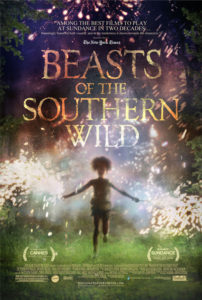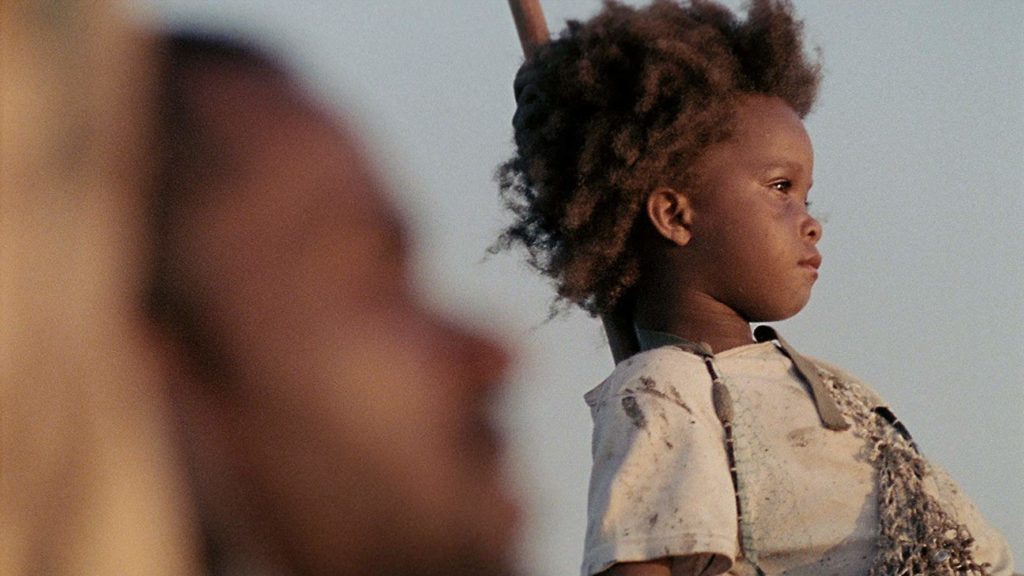Magical Realism Yarn of Childhood Prowls Authentically
DIRECTED BY BENH ZEITLIN/2012

Beasts of the Southern Wild comes at you as something truly wild – wondrously fuzzy, but also matted and mangy. And not without teeth. It is a rough-hewn, jagged-edged full-on immersion into a culture and place so very “other” to the majority of us. (If you’re reading the internet, odds are that you, like I, lack a fundamental understanding or familiarity with the inhabitants of places like “the Bathtub” – the intensely impoverished area this films depicts as existing on the other side of the New Orleans levees.)
With its ramshackle homes (lairs of abandoned signage, plywood and sheet metal rendered shockingly cozy), found-object boats (a hatch from a pick-up truck, a few rusty drum barrels – all of it strung together and somehow seaworthy), and unhinged community (the street celebration that opens the film features a most vibrant depiction of eating, drinking, and being merry, complete with children running loose with fireworks. Gloriously so), this is absolutely not the people who “keep their babies in strollers, and eat their fish from plastic wrappers.” That’s a quote (close enough, anyhow) from the film’s six year old lead, a pained but also blissfully wayward little girl who sees, knows, and processes her world as only a six year old can.
Hushpuppy, amazingly portrayed by Quvenzhané Wallis, has known no other existence. She’s elevated her gone mother’s memory to fairy tale-like proportions, albeit the classically darker and unsanitized fairy tales. Her father, Wink, (Dwight Henry) comes and goes, an aggressively harsh man who loves his daughter intensely, and can’t begin to know how to show it. Ruled by a frightening temper and perpetually broke (an epidemic in the bathtub) but always with enough money for booze – he only wants what’s best for his daughter, his only child and enduring legacy in an uncontrollable cataclysmic world. (And yet…)

The Bathtub is filling up with too much water. Nature is running apocalyptically amok, but on the other hand, it’s nothing a little well placed dynamite can’t fix. These are the human beasts (as we all are when it comes down to it), bound to chew their way out of their trap. Is it Hurricane Katrina? Possibly. But that’s no question for a six year old. The altruistic outside world’s idea of help – relocation – only serves to get those pesky interlopers fired upon and/or yelled at. For these people, leaving the Bathtub is not an option. Nature is a shifting thing, and these inhabitants – never negatively portrayed as “other” nor hyper-romanticized in their squalor – are determined to hold their ground, and shift along with it. Or at least resist broader cultural assimilation. Indeed, when some of the characters find themselves whisked away to an aesthetically lifeless and sterile help center, the film, like their lives, degenerates to a prison break scenario, a singular focus. Thankfully, recovery isn’t far off.
Director/writer Benh Zeitlin, although relatively new to the game, is without question one to keep a close eye on. More so than any other filmmaker of recent memory, he understands not just the significance of on-screen authenticity that can lurk in the details of a movie (the props, the location, the people), but the transcending power those elements can bring. On paper, Beasts of the Southern Wild reads like an American social problem film through the filter of Hayeo Miyazaki. (Are those wondrous creatures glimpsed throughout the film real or imagined? And does that matter?) But no great film can be truly known by what is on paper. It must be, it demands to be, experienced. Whole-heartedly and immersively. Beasts of the Southern Wild is just such an all-too-rare film. The way that actors know a kinship and tether to their props and locations is a palpable rarity.
Although life in the Bathtub is rough and, for the most part, not our own, there can be a certain cleansing that comes from wallowing about in it for a time. Zeitlin is skilled enough to evoke a certain universality in the struggles and apartness of the life experience of these people. Somehow, we are able to relate to them. This, despite the fact that their lives are incredibly different from the lives so many of us know, one of immediately heightened levels of comfort and convenience via ratcheted up artifice (air conditioning, processed foods, etc.) The give and take is made stunningly clear. (Another excellent recent film, Bombay Beach – itself all the more beneath the radar than this one – does a very similar thing in a non-narrative fashion with the forgotten people of the Salton Sea.)
The fact that Beasts of the Southern Wild achieves so much (societal examination, familial dysfunction, and mythical bears, oh my!) as well as it does in just over ninety minutes is a point of achievement. Although we are placed in the shoes of an impoverished New Orleans child, the eyes we’re truly seeing this through is of course that of a grown man, one with a movie camera and film crew. But Zeitlin casts his illusion of raw authenticity brilliantly, by getting as close to the authenticity as one can (without letting it damagingly crack through his glass lens, although heaven knows it may be capable). With his camera and film crew, he is somehow not another altruistic interloper looking to shine a progressively guided light on these poor, poor people (which is the precise point most Hollywood efforts in this vein would extent toward, and never beyond). Beasts of the Southern Wild, carried by Wallis, does far more than scratch the surface of that strangely integral place where reality and imagination can uneasily and immediately combine.

